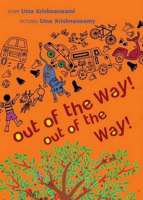
On her way to visit her daughter on the other side of the jungle, Grandma encounters a hungry fox, bear, and tiger, and although she convinces them to wait for her return trip, she still must find a way to outwit them all.
Materials from India

On her way to visit her daughter on the other side of the jungle, Grandma encounters a hungry fox, bear, and tiger, and although she convinces them to wait for her return trip, she still must find a way to outwit them all.

The water from a magical well in their farmhouse was the reason behind this ‘good fortune’, they said. One day, fifteen-year-old Gurmi sets out to look for the well and what he sees changes everyone’s world forever. The faces of three girls look up at him from the water, and draw him into a world of fun, games and cyber magic -and Gurmi has to face up to an unnerving truth as murky as the surreal well. What terrible crimes have been committed behind the walls of the rambling Diwanchand family home? Will Gurmi and the ghost-girls be able to avenge the evil that has taken place and prevent yet another unspeakable atrocity from occurring? Funny, yet sensitive and immensely powerful, Faces in the Water is the story of lives lost to appease our society’s insatiable hunger for male children, and the price families pay for its sake.
See the review at WOW Review, Volume 5, Issue 3

As Rosalind continues to straddle the proper English world of her family and the culture of 1920s India where they live, her support of Gandhi and his followers in opposing British rule grows and she considers trying to carry the rebels’ message to Edward, Prince of Wales, during his visit.

How can a king knock some sense into his silly sons so that they grow up sensible young men? A wise man tells the king that he can do the job in six weeks. Every time one of the boys says or does something rash, the sage will put him back on the straight and narrow by telling him a cautionary tale – the story of a proud hare, or perhaps an owl, or a crow… This collection of fables, known as the Panchatantra and familiar all over Asia, were first told, then written down in Sanskrit over 2,000 years ago. Jamila Gavin brings them alove for modern readers by telling the story of the wise man and the young princes as original stories framing the classic animal fables. The result is a powerful and unique vision of this classic Indian work.

In this beautiful picturebook written by Governor General’s Award-winning author Rachna Gilmore and illustrated by India’s most renowned illustrator, Pulak Biswas, a little girl nearly drowns when a swollen river overflows its banks. Tragically, her beloved mother and father are swept away in the flood. Raised by a cruel and uncaring aunt and uncle, the little girl finds solace in her mother’s magic flute. The Flute is an enchanting tale of the power of hope and the resilience of the human spirit.

With a special focus on Indian children, this book captures the stunning variety of life in a country that is also a subcontinent. Using an A-Z format, Prodeepta Das introduces young readers to social details both ancient and modern, such as the happy chaos of bustling cities, where the cinema rules, as well as the quiet traditions of rural life. I Is for India contains beautiful images of everything from Mehndi, elaborate filigrees of tattoos worn by young women at weddings and festivals, to the country’s splendid national bird, the peacock.

Draws eight stories from well-known collections of Indian folktales–Hitopadesha tales, Jataka tales, and Panchantra tales–and presents them with cartoon-like illustrations.

When British schoolboy Ash Mistry goes to India for a vacation, he quickly falls into a world of rakshasas, or demons, overseen by the evil Lord Alexander Savage.

A young boy spots a baby tree growing in the middle of a dusty path in his village. He carefully places rocks around it as the local mango seller rushes past shouting, ?Out of the way! Out of the way!” As the tree grows bigger, people and animals traverse the path until it becomes a lane, flowing like a river around the tree and getting out of its way. Over time, the lane becomes a road, and a young man crossing the road with his children remembers the baby tree from long ago. By the time he is an old man, the tree has become a giant. The city traffic continues to rattle past, noisier and busier than ever, but sometimes the great tree works its magic, and people just stop, and listen. In this simple, lyrical story, a wide-spreading tree and a busy road grow simultaneously, even as time passes and the footsteps of people and animals give way to speeding cars, buses and trucks.
See the review at WOW Review, Volume 5, Issue 1

Ganesha is just like any thoer kid, except that he has the head of an elephant and rides around on a magical mouse. And he love sweets, especially the traditional dessert laddoo. When Ganesha insists on biting into a super jumbo jawbreaker laddoo, his tusk breaks off! Ganesha is terribly upset, but with the help of the wise post Vyasa, he learns that what seems broken can actually be quite useful after all. The bold, bright colors of India leap right off the page in this fresh and funny picture book adaptation of how Ganesha came to write the epic poem of Hindu literature, the Mahabharate.